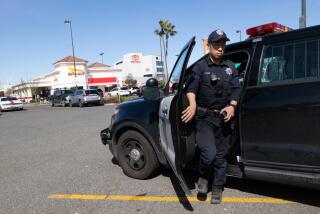L.A. Chief Proposes Ban on Majority of Police Pursuits
- Share via
Los Angeles Police Chief William J. Bratton has proposed banning a majority of police pursuits under a new policy that would also require greater supervision of chases in progress.
Bratton’s proposal, to be considered by the Los Angeles Police Commission today, follows a series of high-profile chases and collisions that resulted in a death and many injuries this year, the latest coming Dec. 3 in Sylmar when fleeing suspects crashed into a minivan, severing the arm of an infant.
“The chief of police is recommending substantial adjustments in the department’s pursuit policy,” said Deputy Chief George Gascon, whose responsibilities include oversight of training and policy development. “It’s a policy we will continue to refine and evaluate.”
The plan would ban the use of infractions -- minor offenses such as broken taillights, missing license plates or minor traffic violations -- to justify a pursuit.
Such offenses now prompt at least 60% of all pursuits by the Los Angeles Police Department, according to a review by the Police Commission, which must approve policy decisions for the department under the city charter.
The proposed change was applauded by the American Civil Liberties Union, which has favored restricting high-speed pursuits since 1996.
“If the Police Commission adopts the new policy, it would be doing what some departments throughout Southern California have already done,” said Ramona Ripston, executive director of the ACLU of Southern California.
“Some of these high-speed pursuits have resulted in harm and even death to innocent bystanders. It’s an ongoing problem and it’s about time the Police Commission changed its policy.”
In choosing a policy for Los Angeles, Gascon said the commission must balance the competing interests of keeping the public safe from pursuits while also keeping it safe from the criminals who might remain free if police don’t chase them.
“It’s a delicate balancing act, so we want to look at where can we adjust the policy to enhance public safety without the unintended consequence of increasing the danger to the community and officers, which is a big concern of Chief Bratton’s,” he said, noting that the Sylmar chase was initiated after a report of a felony stabbing.
The department has proposed tracking fleeing suspects preferably by air, rather than chasing them on the ground, when possible. Bratton also wants to give supervisors, such as watch commanders, control over chases.
Now, LAPD patrol officers have wide discretion on whether to pursue suspects who commit everything from a traffic infraction to a felony. The senior officer involved in the chase has the responsibility to decide whether and when to terminate a pursuit.
Bratton’s proposal would not change the existing policy requiring officers to weigh the potential threat to bystanders against the need to make an arrest, taking into account traffic, pedestrians and the danger posed by the suspect.
Rising pursuit-related accidents, many of which have involved injuries and deaths, have caused the department to reconsider its policy. In March, a driver fleeing police struck pedestrians Anna Polivoda, 76, and her husband, Henry, 79, near the Beverly Center. They suffered broken bones and head injuries. The chase began as the result of a traffic infraction.
A 4-year-old girl was killed in June when an auto-theft suspect being pursued by Los Angeles police ran a red light on a busy downtown street, causing a chain-reaction accident that knocked over a traffic light, crushing the girl.
Then a 2 1/2-week-old boy lost an arm Dec. 3 after his parents’ sport utility vehicle was broadsided by a car occupied by four men fleeing police during a short, high-speed pursuit in Sylmar.
Police chases and injuries among pedestrians resulting from them increased significantly last year, according to Police Commission statistics.
Pursuits rose to 781 in 2001 from 597 the previous year. Pedestrian injuries resulting from chases in 2001 were nearly double those of 1998.
A study by the California Highway Patrol showed that LAPD pursuits decreased 36% from 1995 to 2000. Statewide, the five-year decrease was 32%, according to the CHP.
Bratton, in considering the policy change, also will draw on a study that compares LAPD pursuit statistics and tactics with those of 20 police agencies across the nation.
A study by the Police Commission of chases in Atlanta, Boston, Chicago, Dallas, Las Vegas, Philadelphia and St. Louis found that the LAPD had the highest total -- 781 pursuits, 283 collisions and 139 injuries in 2001.
Only Dallas and Las Vegas experienced a higher percentage of pursuits that resulted in collisions.
As in Los Angeles, officers in Dallas and Las Vegas are allowed to pursue suspects for traffic violations.
Some of the chases have been costly. According to the Los Angeles city attorney, the amount paid out in liability claims stemming from police pursuits from July 2000 to 2001 was $1.32 million. From July 2001 to September 2002, the city paid out approximately $196,400 in claims.
That legal exposure as well as the perceived danger to the public have caused other departments to apply more conservative policies.
The Los Angeles County Sheriff’s Department requires deputies who initiate a pursuit to give watch commanders specific information from the field concerning their speed, location and the reason for the chase, including what type of law was violated. The watch commander then determines whether to chase or not.
Sheriff’s Department spokesman Darren Harris said reasons to terminate a pursuit include unreasonable danger to the deputy, motorists or pedestrians.
The department’s policy is to track suspects with air units whenever they are available.
In Orange County, the Sheriff’s Department does not allow pursuits based on infractions. That policy resulted in eight pursuits in 2001 and just one collision.
More to Read
Sign up for Essential California
The most important California stories and recommendations in your inbox every morning.
You may occasionally receive promotional content from the Los Angeles Times.












